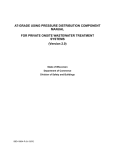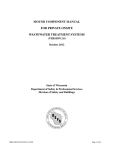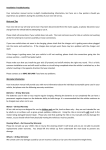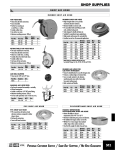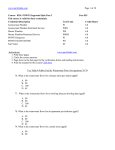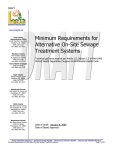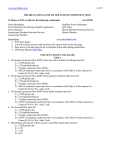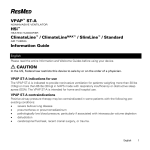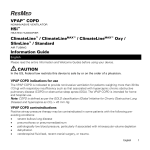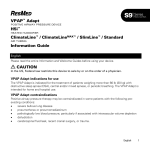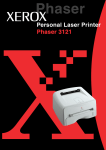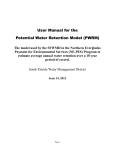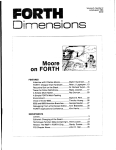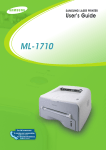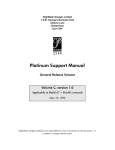Download In-ground soil absorption component manual
Transcript
IN-GROUND SOIL ABSORPTION COMPONENT MANUAL FOR PRIVATE ONSITE WASTEWATER TREATMENT SYSTEMS (VERSION 2.0) October 2012 State of Wisconsin Department of Safety & Professional Services Division of Safety and Buildings SBD-10705-P (N. 01/01; R. 10/12) Page 1 of 32 IN-GROUND SOIL ABSORPTION COMPONENT MANUAL FOR PRIVATE ONSITE WASTEWATER TREATMENT SYSTEMS TABLE OF CONTENTS Page I. Introduction and Specifications 3 II. Definitions 9 III. Description and Principle of Operation 9 IV. Soil and Site Requirements 11 V. Cover Material 11 VI. Design 11 VII. Site Preparation and Construction 19 VIII. Operation, Maintenance and Performance Monitoring 20 IX. References 22 X. In-ground Worksheet 23 XI. Example Worksheet 26 XII. Plan submittal and Installation Inspection 29 Republished on October 2012 by Department of Safety & Professional Services (Published on January 2001 by Dept. of Commerce) Division of Safety and Buildings Safety and Buildings Publication SBD-10705-P (N.01/01; R. 10/12) ADA Statement The Department of Safety & Professional Services is an equal opportunity service provider and employer. If you need assistance to access services or need material in an alternate format, please contact the Department at (608) 266-3151. Deaf, hearing or speech-impaired callers may reach the Department through WI-TRS (Wisconsin Telecommunication Relay System). SBD-10705-P (N. 01/01; R. 10/12) Page 2 of 32 I. INTRODUCTION AND SPECIFICATIONS This Private Onsite Wastewater Treatment System (POWTS) component manual provides design, construction, inspection, operation, and maintenance specifications for an in-ground soil absorption component. However, these items must accompany a properly prepared and reviewed plan acceptable to the governing unit to help provide a system that can be installed and function properly. Violations of this manual constitute a violation of chs. SPS 383 and 84, Wis. Adm. Code. The in-ground soil absorption component must receive influent flows and loads less than or equal to those specified in Table 1. When designed, installed and maintained in accordance with this manual, the in-ground soil absorption component provides treatment and dispersal of domestic wastewater in conformance with ch. SPS 383 of the Wis. Adm. Code. Final effluent characteristics will comply with s. SPS 383.41, Wis. Adm. Code when inputs are within the range specified in Tables 1 to 3. Note: Detailed plans and specifications must be developed and submitted for reviewed and approved by the governing unit having authority over the plan for the installation. Also, a Sanitary Permit must be obtained from the department or governmental unit having jurisdiction. See Section XII for more details. Table 1 INFLUENT FLOWS AND LOADS Design Wastewater flow (DWF) ≤ 5000 gal/day Dosing of Effluent required when DWF > 1500 gal/day Monthly average value of Fats, Oil and Grease ≤ 30 mg/L (FOG) Monthly average value of five day Biochemical ≤ 220 mg/L Oxygen Demand (BOD5) Monthly average value of Total Suspended ≤ 150 mg/L Solids (TSS) Wastewater particle size ≤ 1/8 inch Design wastewater flow (DWF) for flow from Based on s. SPS 383.43 (3), (4) or (5), Wis. one- or two-family dwellings Adm. Code Design wastewater flow (DWF) from public ≥ 150% of estimated wastewater flow in facilities accordance with Table 4 of this manual or s. SPS 383.43 (6), Wis. Adm. Code Volume of a single dose when a pressure ≥ 5 times the void volume of the distribution distribution system is utilized to disperse lateral(s) and ≤ 20% of the design wastewater effluent [Use of pressure distribution is dictated flow by s. SPS 383.44(5)] Volume of a single dose to soil absorption ≤ 20% of the design wastewater flow component when effluent is delivered to a nonpressure distribution system Distribution cell area per orifice when pressure ≤ 12 ft2 distribution system is used SBD-10705-P (N. 01/01; R. 10/12) Page 3 of 32 Table 2 SIZE AND ORIENTATION Minimum area of distribution cell ≥ Design wastewater flow ÷ soil application rate for the in situ soil at the infiltrative surface or a lower horizon if the lower horizon adversely affects the dispersal of wastewater in accordance with s. SPS 383.44 (4) (a) and (c) , Wis. Adm. Code Distribution cell width ≥ 1 foot and ≤ 6 feet Distribution cell depth ≥ 8 inches + nominal size of distribution pipe Depth of cover over top of distribution cell ≥ 12 inches Depth of cover over top of distribution cell ≥ 0 inches measured from in situ soil surface Table 3 OTHER SPECIFICATIONS Slope of in situ soil ≤ 25% in area of component Vertical separation between distribution cell and ≥ Equal to depth required by s. SPS 383 seasonal saturation defined by redoximorphic Table 383.44-3, Wis. Adm. Code features, groundwater, or bedrock Bottom of distribution cell Level Horizontal separation between distribution cells ≥ 3 ft. Distance between bottom of distribution lateral ≥ 6 inches and in situ soil when stone aggregate is used Distance between top of distribution lateral and ≥ 2 inches geotextile fabric when stone aggregate is used Distribution cell stone aggregate material Meets requirements of s. SPS 384.30 (6) (i), Wis. Adm. Code for stone aggregate Piping material in the distribution system Meets requirements of s. SPS 384.30 (2), Wis. Adm. Code for its intended use Piping material for observation, vent, and Meets requirements of s. 84.30 Table 384.30-1, observation/vent pipes Wis. Adm. Code Leaching chamber Meets requirements of s. SPS 384.30 (6) (h), Wis. Adm. Code Geotextile fabric cover over distribution cell Geotextile fabric meeting s. SPS 384.30 (6) (g), when stone aggregate is used Wis. Adm. Code Slope of gravity flow perforated distribution ≤ 4 inches per 100 feet away from distribution lateral piping boxes, drop boxes or header SBD-10705-P (N. 01/01; R. 10/12) Page 4 of 32 Table 3 OTHER SPECIFICATIONS (continued) Location of gravity flow perforated distribution Centered in the width of the cell or equally pipe in distribution cell spaced in the width of the cell Location of leaching chambers in distribution Located as follows: cell 1. Single row of chambers that are in contact with the soil of the distribution cell walls, or 2. Multiple rows of chambers that are in contact with each other and have the outside sides in contact with the soil of the distribution cell walls Length of distribution pipe for components ≥ Equal to length of distribution cell minus 6 feet using stone aggregate and gravity flow distribution Distance between distribution pipe end orifice ≤ 3 feet and end of distribution cell for components using stone aggregate and gravity flow distribution Length of leaching chamber row Chambers extend to end walls of distribution cell Number of observation pipes per distribution ≥2 cell Location of observation pipes For flexibility in pipe location, see VII. C. 5. Design and installation of observation pipes 1. Have an open bottom installed in stone aggregate 2. Have a nominal pipe size of 4 inches 3. The lower 6 inches slotted 4. Slots are ≥ 1/4” and ≤ 1/2” in width and located on opposite sides 5. Anchored in a manner that will prevent the pipe from being pulled out 6. Extend from the infiltrative surface up to or above finish grade 7. Terminate with a removable watertight cap, or 8. Terminate with a vent cap if > 12 inches above finish grade SBD-10705-P (N. 01/01; R. 10/12) Page 5 of 32 Table 3 OTHER SPECIFICATIONS (continued) Design and installation of observation pipes 1. Have an open bottom installed on leaching chambers 2. Have a nominal pipe size of 4 inches 3. Anchored to the leaching chamber in a manner that will prevent the pipe from being pulled out 4. Extend from a distance ≥ 4inches above the infiltrative surface through the top of the leaching chamber up to or above finish grade 5. Terminate with a removable watertight cap, or 6. Terminate with a vent cap if > 12 inches above finish grade Effluent application to distribution cell 1. If DWF < 1500 gpd, effluent may be applied by gravity flow, dosed to distribution cell or distribution box, then applied by gravity flow to the distribution cell, or by use of pressure distribution, unless pressure distribution is required in accordance with s. SPS 383.44 (5) (b) 2. If DWF ≥ 1500 gpd, effluent must be dosed to distribution cell or distribution box, then applied by gravity flow to the distribution cell, or by use of pressure distribution, unless pressure distribution is required in accordance with s. SPS 383.44 (5) (b) , Wis. Adm. Code Septic tank effluent pump system Meets requirements of s. SPS 384.10, Wis. Adm. Code and this manual Dosing effluent to leaching chambers Protection of the infiltrative surface must be provided to prevent erosion at the area where the effluent enters the chamber SBD-10705-P (N. 01/01; R. 10/12) Page 6 of 32 Table 3 OTHER SPECIFICATIONS (continued) Dose tank or compartment volume employing one ≥ Volume of a single dose + reserve capacitya + pump drain back volumeb + (6 inches x average gal/inch of tank)c Dose tank or compartment volume employing duplex pumps Siphon tank or compartment volume Distribution network for pressurized distribution systems. Note: Pressure distribution is required when soils or effluent meets parameters of s. 83.44 (5), Wis. Adm. Code. SBD-10705-P (N. 01/01; R. 10/12) Notes: a: Reserve capacity ≥ the estimated daily flow. b: Drain back volume ≥ volume of wastewater that will drain into the dose tank from the distribution cell. c: Four inches of this dimension ≥ vertical distance from pump intake to bottom of tank. Two inches of this dimension ≥ vertical distance between pump on elevation and high water alarm activation elevation. ≥ Volume of a single dose + drain back volumea + (6 inches x average gal/inch of tank)b Notes: a: Drain back volume ≥ volume of wastewater that will drain into the dose tank from the force main. b: Four inches of this dimension ≥ vertical distance from pump intake to bottom of tank. Two inches of this dimension ≥ vertical distance between pump on elevation and high water alarm activation elevation. ≥ What is required to accommodate volumes necessary to provide dosing as specified in this manual By use of pressure distribution network conforming with the sizing methods of either Small Scale Waste Management Project publication 9.6, entitled “Design of Pressure Distribution Networks for Septic Tank – Soil Absorption Systems” or Dept. of Commerce publications SBD-10573-P or SBD-10706-P, entitled Pressure Distribution Component Manual for Private Onsite Wastewater Treatment Systems”. Page 7 of 32 Table 3 OTHER SPECIFICATIONS (continued) Vent pipes installed in stone aggregate system 1. Connect to a gravity flow distribution lateral by the use of a fitting 2. Have a nominal pipe size of 4 inches 3. Extend from the distribution lateral > 12 inches above finish grade 4. Terminate in a manner that will allow a free flow of air between the distribution lateral and the atmosphere 5. The vent opening port is downward Vent pipes installed on leaching chambers 1. Anchored to the leaching chamber in a manner that will prevent the pipe from being pulled up 2. Have an open bottom 3. Have a nominal pipe size of 4 inches 4. Extend from inside of the leaching chamber > 12 inches above finish grade 5. Terminate in a manner that will allow a free flow of air between the leaching chamber and the atmosphere 6. The vent opening port is downward Combination observation/vent pipes installed in Meets all of the requirements of observation a stone aggregate system pipes with the following exceptions: 1. Have a minimum 4 inch pipe connection to a distribution lateral 2. Connect to the vent pipe at a point above the stone aggregate 3. Extend from the infiltrative surface > 12 inches above finish grade 4. Terminate in a manner that will allow a free flow of air between the distribution lateral and the atmosphere 5. The vent opening port is downward Combination observation/vent pipes installed on Meets all of the requirements of observation a leaching chamber pipes with the following exceptions: 1. Extend from the infiltrative surface ≥ 12 inches above finish grade 2. Terminate in a manner that will allow a free flow of air between the leaching chamber and the atmosphere 3. The vent opening port is downward SBD-10705-P (N. 01/01; R. 10/12) Page 8 of 32 Table 3 OTHER SPECIFICATIONS (continued) Cover material over the geotextile fabric or Soil that will provide frost protection, prevent leaching chamber erosion and excess precipitation or runoff infiltration and allow air to enter the distribution cell Installation inspection In accordance with ch. SPS 383, Wis. Adm. Code Management In accordance with ch. SPS 383, Wis. Adm. Code and this manual II. DEFINITIONS Definitions not found in this section are located in ch. SPS 381, Wis. Adm. Code or the terms use the standard dictionary definition. A. “Cobbles” means rock fragments greater than 3 inches, but less than 10 inches in diameter. B. “Septic tank effluent pump system” means a septic tank which has a pump installed in the tank that will pump effluent from the clear zone. C. “Site plan” means a scaled or completely dimensioned drawing, drafted by hand or computer aided technology, presented in a permanent form that shows the relative locations of setback encumbrances to a regulated object. The site plan also includes a reference to north and the permanent vertical and horizontal reference point or benchmark. D. “Stones” means rock fragments found in soil material that are greater than 10 inches in diameter, but less than 24 inches. III. DESCRIPTION AND PRINCIPLE OF OPERATION In-ground soil absorption component operation is a two-stage process involving both wastewater treatment and dispersal. Treatment is accomplished predominately by physical and biochemical processes within the treatment/dispersal zone. The physical characteristics of the influent wastewater, influent application rate, temperature, and the nature of the receiving soil affect these processes. Physical entrapment, increased retention time, and conversion of pollutants in the wastewater are important treatment objectives accomplished under unsaturated soil conditions. Pathogens contained in the wastewater are eventually deactivated through filtering, retention, and adsorption by in situ soil. Dispersal is primarily affected by the depth of the unsaturated receiving soil, the soil’s hydraulic conductivity, influent application rate, land slope, and the area available for dispersal. SBD-10705-P (N. 01/01; R. 10/12) Page 9 of 32 The in-ground soil absorption component consists of a distribution cell. Influent is discharged to the distribution cell where it flows through the void area formed by stone aggregate and perforated pipe or leaching chambers and then passes into the underlying in situ soil for treatment and dispersal to the environment. The soil, to the prescribed depth, beneath the distribution cell is considered part of the cell known as the treatment/dispersal zone. See Figures 1 & 2. Cover material over the geotextile fabric or leaching chamber is to provide frost protection, prevent erosion protection, a barrier to excess precipitation or runoff infiltration, and allows oxygen transfer. The in situ soil within the treatment/dispersal zone provides the physical and biochemical treatment for the influent. Figure 1 - Cross-section of an in-ground soil absorption component with multiple laterals Figure 2 - Cross-section of an in-ground soil absorption component with a single lateral SBD-10705-P (N. 01/01; R. 10/12) Page 10 of 32 IV. SOIL AND SITE REQUIREMENTS Every in-ground soil absorption component design is ultimately matched to the given soil and site. The design approach presented in this manual is based on criteria that all applied wastewater is successfully transported away from the system, that it will not affect subsequent wastewater additions, that the effluent is ultimately treated and that reaeration of the infiltrative surface will occur. A. Minimum Soil Depth Requirements The minimum soil factors required for successful in-ground soil absorption component performance are listed in the introduction and specification section of this manual. Soil evaluations must be in accordance with ch. SPS 385 of the Wis. Adm. Code. In addition, soil application rates and depth must be in accordance with ch. SPS 383 of the Wis. Adm. Code. B. Other Site Considerations 1. In-ground soil absorption component location - In open areas, exposure to sun and wind increases the assistance of evaporation and transpiration in the dispersal of the wastewater. 2. Sites with trees and large boulders - Generally, sites with large trees, numerous smaller trees or large boulders are less desirable for installing an in-ground soil absorption component because of difficulty in preparing the distribution cell area. As with rock fragments, tree roots, stumps and boulders occupy area, thus reducing the amount of soil available for proper treatment. If no other site is available, trees in the distribution cell area must be removed. 3. Setback distances - The setbacks specified in ch. SPS 383, Wis. Adm. Code for soil subsurface treatment/dispersal component, apply to in-ground soil absorption components. The distances are measured from the edge of the distribution cell area. V. COVER MATERIAL The cover material is of such quality and is placed so that it will not damage either the geotextile fabric or the leaching chambers. Clays are not recommended as they can restrict oxygen transfer. The cover material must not be compacted while being placed since compaction will reduce vegetative growth and oxygen transfer. VI. DESIGN A. Location, Size and Shape Placement, sizing and geometry of the component must be in accordance with this manual. SBD-10705-P (N. 01/01; R. 10/12) Page 11 of 32 B. Component Design Design of the component is based upon the DWF and the soil characteristics. It must be sized such that it can accept the daily wastewater flow without causing surface seepage or groundwater pollution. Consequently, the surface area of the treatment and dispersal zone, which is the in situ soil area beneath the component, must be sufficiently large enough to absorb the applied effluent into the underlying soil. The component must also be designed to avoid encroachment of the water table into the treatment and dispersal zone. Design of the component includes three major steps, which are: (A) calculating DWF, (B) calculating soil infiltration area, and (C) design of the distribution cell. Each step is discussed below. Step A: Design Wastewater Flow Calculations One- and two-family dwellings. Distribution cell size for one- and two-family dwelling application is determined by calculating the design wastewater flow (DWF). To calculate DWF use Formulas 1, 2 or 3. Formula 1 is for combined wastewater flows, which consist of blackwater, clearwater and graywater. Formula 2 is for clearwater and graywater only. Formula 3 is for blackwater only. Formula 1 Combined wastewater DWF = 150 gal/day/bedroom Formula 2 Clearwater & Graywater DWF = 90 gal/day/bedroom Formula 3 Blackwater DWF = 60 gal/day/bedroom Public Facilities. Distribution cell size for public facilities application is determined by calculating the DWF using Formula 2. Only facilities identified in Table 4 are included in this manual. Estimated daily wastewater flows are determined in accordance with Table 4 or s. SPS 383.43(6), Wis. Adm. Code. Many commercial facilities have high BOD5, TSS and FOG (fats, oils and grease), which must be pretreated in order to bring their values down to an acceptable range before entering into the inground soil absorption component described in this manual. Formula 2 DWF = Sum of each estimated wastewater flow per source per day x 1.5 Where 1.5 = Conversion factor to convert estimated wastewater flow to design wastewater flow SBD-10705-P (N. 01/01; R. 10/12) Page 12 of 32 Source Table 4 Public Facility Wastewater Flows Unit Apartment or Condominium Assembly hall (no kitchen) Bar or cocktail lounge (no meals served) Bar or cocktail lounge* (w/meals - all paper service) Beauty salon Bowling alley Bowling alley (with bar) Camp, day and night Camp, day use only (no meals served) Campground or Camping Resort Campground sanitary dump station Catch basin Church (no kitchen) Church* (with kitchen) Dance hall Day care facility (no meals prepared) Day care facility* (with meal preparation) Dining hall* (kitchen waste only without dishwasher and/or food waste grinder) Dining hall* (toilet and kitchen waste without dishwasher and/or food waste grinder) Dining hall* (toilet and kitchen waste with dishwasher and/or food waste grinder) Drive-in restaurant* (all paper service with inside seating) Drive-in restaurant* (all paper service without inside seating) Drive-in theater Employees (total all shifts) Floor drain (not discharging to catch basin) Gas station / convenience store Gas station (with service bay) Patron Service bay Hospital* Hotel, motel or tourist rooming house Medical office building Doctors, nurses, medical staff Office personnel Patients Migrant labor camp (central bathhouse) * = May be high strength waste SBD-10705-P (N. 01/01; R. 10/12) Estimated Wastewater Flow (gpd) 100 1.3 4 8 90 80 150 25 10 30 Bedroom Person (10 sq. ft./person) Patron (10 sq. ft./patron) Patron (10 sq. ft./patron) Station Bowling lane Bowling lane Person Person Space, with sewer connection and/or service building Camping unit or RV served Basin Person Person Person (10 sq. ft./person) Child Child Meal served 25 65 2 5 2 12 16 2 Meal served 5 Meal served 7 Patron seating space Vehicle space 10 10 Vehicle space Employee Drain Patron (minimum 500 patrons) 3 13 25 3 Patron Service bay Bed space Room 3 50 135 65 Person Person Person Employee 50 13 6.5 20 Page 13 of 32 Source Table 4 Public Facility Wastewater Flows (continued) Unit Mobile Home (Manufactured home) (served by its own POWTS) Mobile home park Nursing, Rest Home, Community Based Residential Facility Outdoor sport facilities (toilet waste only) Parks (toilets waste only) Parks (toilets and showers) Public shower facility Restaurant*, 24-hr. (dishwasher and/or food waste grinder only) Restaurant*, 24-hr. (kitchen waste only without dishwasher and/or food waste grinder) Restaurant, 24-hr. (toilet waste) Restaurant*, 24-hr. (toilet and kitchen waste without dishwasher and/or food waste grinder) Restaurant*, 24-hr. (toilet and kitchen waste with dishwasher and/or food waste grinder) Restaurant* (dishwasher and/or food waste grinder only) Restaurant* (kitchen waste only without dishwasher and/or food waste grinder) Restaurant (toilet waste) Restaurant* (toilet and kitchen waste without dishwasher and/or food waste grinder) Restaurant* (toilet and kitchen waste with dishwasher and/or food waste grinder) Retail store School* (with meals and showers) School* (with meals or showers) School (without meals or showers) Self-service laundry (toilet waste only) Self-service laundry (with only residential clothes washers) Swimming pool bathhouse * = May be high strength waste SBD-10705-P (N. 01/01; R. 10/12) Bedroom Estimated Wastewater Flow (gpd) 100 Mobile home site Bed space Patron Patron (75 patrons/acre) Patron (75 patrons/acre) Shower taken Patron seating space 200 65 3.5 3.5 6.5 10 4 Patron seating space 12 Patron seating space Patron seating space 28 40 Patron seating space 44 Patron seating space Patron seating space 2 6 Patron seating space Patron seating space 14 20 Patron seating space 22 Patron (70% of total retail area ÷ 30 sq. ft. per patron) Classroom (25 students/classroom) Classroom (25 students/classroom) Classroom (25 students/classroom) Clothes washer Clothes washer Patron 1 500 400 300 33 200 6.5 Page 14 of 32 Step B: Sizing the Distribution Cell Area The required distribution cell area is based on the DWF and the slowest soil application rate of the in situ soil at the infiltrative surface or a lower horizon if the lower horizon adversely affects the dispersal of wastewater in accordance with s. SPS 383.44 (4) (a) and (c). Wastewater application rates to the soil are found in ch. SPS 383, Tables 83.44-1 and 83.44-2, Wis. Adm. Code. Using the above information, the required distribution cell area can be determined using the following formula: Area = DWF ÷ Application rate of the in situ soil in accordance with s. SPS 383.44 (4) (a) and (c), Wis. Adm. Code. Note: This area may include the area of more than one distribution cell. Step C: Component Configuration The maximum distribution cell width is six feet. The maximum length and width of the distribution cell is dependent on setback requirements of s. SPS Table 383.43-1, Wis. Adm. Code, and soil evaluation results. Where possible, on sloping sites, the distribution cell is aligned with its longest dimension parallel to the land surface contours so as not to concentrate the effluent into a small area as it moves vertically and horizontally down slope. Distribution Cell Height The distribution cell height provides effluent storage and support of the piping within the distribution cell. The minimum height of the distribution cell, when stone aggregate is used in gravity distribution components is 12 inches or 9 inches when pressure distribution is used. This provides a minimum space of 6 inches beneath the distribution pipe and 2 inches above the distribution piping, as specified in the specification section of this manual. See Figure 3. The minimum depth of the distribution cell when leaching chambers are used is equal to the height of the leaching chamber. See Figure 4. SBD-10705-P (N. 01/01; R. 10/12) Page 15 of 32 Figure 3 - Height of system when using stone aggregate. (All references to Comm 83 codes are replaced by SPS 383 code sections/chapters.) Figure 4 - Height of system using leaching chambers (All references to Comm 83 codes are replaced by SPS 383 code sections/ chapters.) Cover Material A minimum of 12 inches of cover material must be placed over the top of the geotextile fabric or leaching chamber. Finished grade of the cover material must be at or above the surrounding land surface elevation. Depressional areas over the distribution cell that collect and retain surface water runoff must be avoided. SBD-10705-P (N. 01/01; R. 10/12) Page 16 of 32 Distribution Network and Dosing Component The effluent application to the distribution cell may be by gravity or pressure, and may consist of piping or leaching chambers. Distribution boxes or drop boxes may be used to distribute effluent to gravity feed distribution cells. Distribution piping for a gravity component has a nominal inside diameter of 4 inches. The distribution header is non perforated pipe. The slope of gravity flow perforated distribution piping is less than or equal to 4 inches per 100 feet away from distribution boxes, drop boxes or header. When a drop box design is used, the invert of the drop box overflow pipe must be at least 4 inches lower than the invert of the treatment tank outlet or force main connection. The design and installation of distribution boxes must be watertight and capable of providing a means of providing equal distribution of effluent to each distribution cell. Drop boxes must be watertight and capable of distributing effluent to another distribution cell. Components that are designed to receive a DWF greater than 1500 gal/day, dose the effluent to the distribution cell by means of a pump or siphon. The dose chamber shall contain sufficient volume to dose the distribution cell as required by its system design, retain drain back volume, contain a one day reserve zone, provide a minimum 2 inch separation between alarm activation and pump-on activation, and allow for protection of the pump from solids. Drain back volumes can be calculated based on values listed in Table 5. Table 5 VOID VOLUME FOR VARIOUS DIAMETER PIPES BASED ON NOMINAL I.D.a Nominal Pipe Size Gallons per Foot 1-1/4 0.064 1-1/2 0.092 2 0.163 3 0.367 4 0.65 6 1.469 2 Note a: Table is based on - π(d/2) x 12”/ft ÷ 231 cu.in./cu.ft. Where: d = nominal pipe size in inches A reserve capacity is required on a system with only one pump. The reserve volume must be equal to or greater than the estimated daily wastewater flow. Reserve capacity may be calculated using 100 gallons per bedroom per day for one and two family residences or the values computed by using Table 4. The dose volume shall be included in the sizing of the dose chamber. (Volume of a septic tank effluent pump system is determined by department plumbing product approval.) The pump alarm activation point must be at least 2 inches above the pump activation point. SBD-10705-P (N. 01/01; R. 10/12) Page 17 of 32 Allow “dead” space below the pump intake to permit settling of solids in the dose chamber. This can be accomplished by placing the pump on concrete blocks or other material that can form a pedestal. The pump manufacturer’s requirements shall be followed. This may include the “pump off” switch being located high enough to allow for complete immersion of the pump in the dose chamber. Leaching chamber tops are at or below the original grade. Leaching chambers are placed directly on the bottom of the distribution cell. The locations of leaching chambers are in accordance with Table 3 of this manual. Observation pipes are installed in the distribution cells and are provided with a means of anchoring to prevent them from being lifted up. Observation pipes extend from the infiltrative surface for stone aggregate systems or from the inside of leaching chambers to a point at or above finish grade. The portion of the observation pipe below the distribution pipe for stone aggregate systems is slotted while the portion above the distribution pipe is solid wall. Observation pipes for leaching chamber systems are attached to the chambers in accordance with the chamber manufacturer’s printed instructions, extend from a distance ≥ 4inches above the infiltrative surface through the top of the leaching chamber up to or above finish grade and terminate with a removable watertight cap. All observation piping has a nominal pipe size of 4 inches. See Figure 5. Figure 5 - Observation pipes Vent pipes, if installed, connect to the upper half of the gravity flow distribution laterals and extend up to at least 12 inches above finish grade. Vent pipes terminate with the vent opening facing downward by the means of a vent cap or fittings. Vent caps must allow a free flow of air between the distribution lateral and the atmosphere. All vent pipes has a nominal pipe size of 4 inches. When a vent pipe is connected to an observation pipe, the point of connection shall be made at a point above the stone aggregate for stone aggregate systems and terminate as required for vent pipes. An observation pipe may serve as a combination observation/vent pipe providing it terminates in the same manner as required for vent pipes. See Figure 6. SBD-10705-P (N. 01/01; R. 10/12) Page 18 of 32 Figure 6– Vent and combination observation/vent pipes VII. SITE PREPARATION AND CONSTRUCTION Procedures used in the construction of an in-ground soil absorption component are just as critical as the design of the component. A good design with poor construction, results in component failure. It is emphasized that the soil only be worked when the moisture content is low to avoid compaction and smearing. Consequently, installations are to be made only when the soil is dry enough to prevent compaction and smearing of the infiltrative surface. The construction plan to be followed includes: A. Equipment - Proper equipment includes tractors or other equipment that will not compact the infiltrative surface. Minimize foot traffic on infiltrative surface and avoid equipment traffic on or over infiltrative surface. B. Sanitary Permit - Prior to the construction of the component, a sanitary permit, obtained for the installation must be posted in a clearly visible location on the site. Arrangements for inspection(s) must also be made with the department or governmental unit issuing the sanitary permit. C. Construction Procedures 1. Check the moisture content and condition of the soil. If the soil at the infiltrative surface can be rolled into a 1/4-inch wire, the site is too wet, smearing and compaction will result, thus reducing the infiltrative capacity of the soil. If the site is too wet, do not proceed until it dries out. If the soil at or below the infiltrative surface is frozen, do not proceed. 2. Set up a construction level or similar device and determine all relative elevations in relationship to the bench mark. It is necessary to determine the bottom elevation of the distribution cell, land surface contour lines, and approximate component elevations critical to the installation. 3. Lay out the absorption area within the tested designated area. Where possible lay out the absorption areas(s) on the site so that the distribution cell runs parallel with the land surface contours. Reference stakes offset from the corner stakes are recommended in case corner stakes are disturbed during construction. 4. Excavate the distribution cell(s) to the correct bottom elevation(s) taking care not to smear the infiltrative surface. If the infiltrative surface or sidewalls are smeared, loosen it with the use of a rake or similar device. The infiltration surface can be left rough and should not be raked smooth. SBD-10705-P (N. 01/01; R. 10/12) Page 19 of 32 5. Install observation pipes with the bottom 6 inches of the pipe slotted for components using stone aggregate. When leaching chambers are installed, the observation pipe connects to the top of the leaching chamber. Installation of the observation pipe includes a suitable means of anchoring so the pipes are not dislodged during inspections. Observation pipes will be installed in each distribution cell so as to be representative of a cell’s hydraulic performance. Flexibility in location allows that observation pipes: be located such that there are a minimum of two installed in each dispersal cell at opposite ends from one another; be located near the dispersal cell ends; be at least 6 inches from the end wall and sidewall; and be installed at an elevation to view the horizontal or level infiltrative surface within the dispersal cell. Observation pipes may be located less than 6 inches from end walls or side walls if specified in state–approved manufacturers’ installation instructions. 6. If stone aggregate is used, place it into the excavation until the top of the stone aggregate is at the elevation of the distribution piping. Placement of the stone aggregate is done in such a manner as not to compact the infiltrative surface. If leaching chambers are used, install the leaching chambers in accordance with the manufacturer’s installation instructions. 7. Place the distribution pipes, as determined from the design, on the stone aggregate. Connect the distribution box, drop box or manifold to the pipe from the treatment or dosing chamber. 8. Install vent pipe, if one is to be installed as prescribed in Table 3. 9. If stone aggregate is used, place stone aggregate over the distribution pipe and the entire distribution cell until the elevation of the stone aggregate is at least 2 inches above the top of the distribution pipe. 10. If stone aggregate is used, place geotextile fabric conforming to requirements of ch. SPS 384, Wis. Adm. Code, over the stone aggregate. 11. Place the cover material on top of the geotextile fabric and/or leaching chamber. Avoid backfilling the first 12 inches with cobbles, stones, or frozen material that could damage pipe, chamber or fabric. VIII. OPERATION, MAINTENANCE AND PERFORMANCE MONITORING A. The component owner is responsible for the operation and maintenance of the component. The county, department or POWTS service contractor may make periodic inspections of the components, checking for surface discharge, wastewater levels, etc. The owner or owner's agent is required to submit necessary maintenance reports to the appropriate jurisdiction and/or the department. B. Design approval and site inspections before, during, and after the construction are accomplished by the county or other appropriate jurisdictions in accordance to ch. SPS 383, Wis. Adm. Code. C. Routine and preventative maintenance aspects: SBD-10705-P (N. 01/01; R. 10/12) Page 20 of 32 1. Treatment and distribution tanks are to be inspected routinely and maintained when necessary in accordance with the applicable plan or product approval. 2. Inspections of the in-ground soil absorption component performance are required at least once every three years. These inspections include checking the liquid levels in the observation pipes and examination for any seepage around the in-ground soil absorption component. 3. Winter traffic on the in-ground soil absorption component is not permitted to minimize frost penetration and to minimize compaction. 4. A good water conservation plan within the house or establishment will help assure that the inground soil absorption component will not be overloaded. D. User's Manual: A user's manual is to accompany the component. The manual is to contain the following as a minimum: 1. Diagrams of all components and their location. This should include the location of the reserve area, if one is provided. 2. Names and phone numbers of local health authority, component manufacturer or POWTS service contractor to be contacted in the event of component failure or malfunction. 3. Information on the periodic maintenance of the component, including electrical/mechanical components. 4. What activities can or cannot occur on the reserve area, if one is provided. E. Performance monitoring must be performed on components installed under this manual. 1. The frequency of monitoring must be: a. At least once every three years following installation , and b. At time of a problem, complaint, or failure. 2. The minimum criteria addressed in performance monitoring of components are: a. Type of use, b. Age of component, c. Type of component, dosed or gravity feed, d. Nuisance factors, such as odors or user complaints, e. Mechanical malfunction within the component including problems with valves or other mechanical or plumbing components, f. Material fatigue or failure, including durability or corrosion as related to construction or structural design, SBD-10705-P (N. 01/01; R. 10/12) Page 21 of 32 g. Neglect or improper use, such as overloading the design rate, poor maintenance of vegetative cover, inappropriate cover over the component, or inappropriate activity over the component, h. Pretreatment component maintenance, including dosing frequency, structural integrity, groundwater intrusion or improper sizing, i. Pump or siphon chamber maintenance, including improper maintenance, infiltration, structural problems, or improper sizing, j. Ponding in distribution cell, prior to the pump cycle, k. Siphon or pump malfunction including dosing volume problems, breakdown, burnout, or cycling problems, and l. Overflow/seepage problems, as shown by evident or confirmed sewage effluent, including backup. 3. IX. Reports are to be submitted in accordance with ch. SPS 383, Wis. Adm. Code. REFERENCES R.J. Otis, G.D. Plews and D.H. Patterson. “Design of Conventional Soil Absorption Trenches and Beds.” In: Home Sewage Treatment, Proceeding of the Second National Home Sewage Treatment Symposium, ASAE Publication 5-77. United States EPA, EPA 625/1-80-012, October 1980. “Design Manual – Onsite Wastewater Treatment and Disposal Systems.” SBD-10705-P (N. 01/01; R. 10/12) Page 22 of 32 X. IN-GROUND SOIL ABSORPTION COMPONENT WORKSHEET IN-GROUND SOIL ABSORPTION COMPONENT WORKSHEET A. SITE CONDITIONS Evaluate the site and soils report for the following: • Surface water movement. • Measure elevations and distances on the site so that slope, contours and available areas can be determined. • Description of several soil profiles where the system will be located. • Determine the limiting conditions such as bedrock, high groundwater level, soil permeability, and setbacks. Slope - % Occupancy – One or Two-Family Dwelling Public Facility - (# of bedrooms) gal/day (Estimated wastewater flow) inches Depth to limiting factor - Minimum depth of unsaturated soil required by Table 383.44-3, Wis. Adm. Code - inches gal/ft2/day Soil application rate of in situ soil used FOG value of effluent applied to component - mg/L BOD5 value of effluent applied to component - mg/L mg/L TSS value of effluent applied to component - Fecal Coliform monthly geometric mean value of effluent applied to component > 104 cfu/100ml – Yes No Type of distribution cell - Stone aggregate or Leaching chamber B. DESIGN WASTEWATER FLOW (DWF) One- or Two-family Dwelling. Combined wastewater flow: DWF = 150 gal/day/bedroom x # of bedrooms = 150 gal/day/bedroom x = # of bedrooms gal/day SBD-10705-P (N. 01/01; R. 10/12) Page 23 of 32 Clearwater and graywater only: DWF = 90 gal/day/bedroom x # of bedrooms = 90 gal/day/bedroom x = # of bedrooms gal/day Blackwater only: DWF = 60 gal/day/bedroom x # of bedrooms = 60 gal/day/bedroom x = # of bedrooms gal/day Public Facilities. DWF = Estimated wastewater flow x 1.5 = gal/day x 1.5 = gal/day C. WIDTH AND LENGTH OF THE DISTRIBUTION CELL. 1. Determine the design loading rate (DLR) for the site. From Table 383.44-1 or-2, Wis. Adm. Code, select the soil application rate for the most restrictive soil horizon at the infiltrative surface or a lower horizon if the lower horizon adversely affects the dispersal of wastewater in accordance with s. SPS 383.44 (4) (a) and (c). The design loading rate (DLR) is the soil application rate selected from Table 383.44-1 or-2, Wis. Adm. Code, unless the component consists of products that have been recognized through s. SPS 384.50, Wis. Adm. Code, as having a different soil application rate. DLR = _____ gpd/ft2 2. Determine the distribution cell area. Calculate the distribution cell area by dividing the daily design wastewater flow (DWF) by the design loading rate (DLR). Distribution cell area = DWF ÷ DLR Distribution cell area = _____ gpd ÷ ____ gpd/ft2 Distribution cell area = _____ ft2 SBD-10705-P (N. 01/01; R. 10/12) Page 24 of 32 3. Select a width (A) for the distribution cell. The width of the distribution cell can not exceed 6 feet. A = ____ ft 4. Determine the total distribution cell length. Calculate the total distribution cell length (B) by dividing the required distribution area by the distribution cell width (A). B = Distribution cell area ÷ A B = _____ ft2 ÷ ____ ft B = _____ ft SBD-10705-P (N. 01/01; R. 10/12) Page 25 of 32 XI. EXAMPLE WORKSHEET IN-GROUND SOIL ABSORPTION COMPONENT WORKSHEET A. SITE CONDITIONS Evaluate the site and soils report for the following: • Surface water movement. • Measure elevations and distances on the site so that slope, contours and available areas can be determined. • Description of several soil profiles where the system will be located. • Determine the limiting conditions such as bedrock, high groundwater level, soil permeability, and setbacks. Slope - % Occupancy – One or Two-Family Dwelling Public Facility - 4 (# of bedrooms) gal/day (Estimated wastewater flow) Depth to limiting factor - 60 inches Minimum depth of unsaturated soil required by Table 383.44-3, Wis. Adm. Code - 36 inches Soil application rate of in situ soil used - 0.8 gal/ft2/day FOG value of effluent applied to component - 20 BOD5 value of effluent applied to component - 180 TSS value of effluent applied to component - 120 mg/L mg/L mg/L Fecal Coliform monthly geometric mean value of effluent applied to component > 104 cfu/100ml – Yes No Type of distribution cell - X Stone aggregate or Leaching chamber B. DESIGN WASTEWATER FLOW (DWF) One- or Two-family Dwelling. Combined wastewater flow: DWF = 150 gal/day/bedroom x # of bedrooms = 150 gal/day/bedroom x = 600 4 # of bedrooms gal/day SBD-10705-P (N. 01/01; R. 10/12) Page 26 of 32 Clearwater and graywater only: DWF = 90 gal/day/bedroom x # of bedrooms = 90 gal/day/bedroom x = # of bedrooms gal/day Blackwater only: DWF = 60 gal/day/bedroom x # of bedrooms = 60 gal/day/bedroom x = # of bedrooms gal/day Public Facility. DWF = Estimated wastewater flow x 1.5 = gal/day x 1.5 = gal/day C. WIDTH AND LENGTH OF THE DISTRIBUTION CELL. 1. Determine the design loading rate (DLR) for the site. From Table 383.44-1 or-2, Wis. Adm. Code, select the soil application rate for the most restrictive soil horizon at the infiltrative surface or a lower horizon if the lower horizon adversely affects the dispersal of wastewater in accordance with s. SPS 383.44 (4) (a) and (c). The design loading rate (DLR) is the soil application rate selected from Table 383.44-1 or-2, Wis. Adm. Code, unless the component consists of products that have been recognized through s. SPS 384.50, Wis. Adm. Code, as having a different soil application rate. DLR = 0.8 gpd/ft2 2. Determine the distribution cell area. Calculate the distribution cell area by dividing the daily design wastewater flow (DWF) by the design loading rate (DLR). Distribution cell area = DWF ÷ DLR Distribution cell area = 600 gpd ÷ 0.8 gpd/ft2 Distribution cell area = 750 ft2 SBD-10705-P (N. 01/01; R. 10/12) Page 27 of 32 3. Select a width (A) for the distribution cell. The width of the distribution cell can not exceed 6 feet. A = 6 ft 4. Determine the total distribution cell length. Calculate the total distribution cell length (B) by dividing the required distribution area by the distribution cell width (A). B = Distribution cell area ÷ A B = 750 ft2 ÷ 6 ft B = 125 ft SBD-10705-P (N. 01/01; R. 10/12) Page 28 of 32 XII. PLAN SUBMITTAL AND INSTALLATION INSPECTION A. Plan Submittal In order to install a system correctly, it is important to develop plans that will be used to install the system correctly the first time. The following checklist may be used when preparing plans for review. The checklist is intended to be a general guide. Not all needed information may be included in this list. Some of the information listed may not be required to be submitted due to the design of the system. Conformance to the list is not a guarantee of plan approval. Additional information may be needed or requested to address unusual or unique characteristics of a particular project. Contact the reviewing agent for specific plan submittal requirements, which the agency may require that are different than the list included in this manual. General Submittal Information • Photocopies of soil report forms, plans, and other documents are acceptable. However, an original signature is required on certain documents. • Submittal of additional information requested during plan review or questions concerning a specific plan must be referenced to the Plan Identification indicator assigned to that plan by the reviewing agency. • Plans or documents must be permanent copies or originals. Forms and Fees • Application form for submittal, provided by reviewing agency along with proper fees set by reviewing agent. Soils Information • Complete Soils and Site Evaluation Report (form # SBD-8330) for each soil boring described; signed and dated by a certified soil tester, with credential number. • Separate sheet showing the location of all borings. The location of all borings and backhoe pits must be able to be identified on the plot plan. Documentation • Architects, engineers or designers must sign, seal and date each page of the submittal or provide an index page, which is signed, sealed and dated. • Master Plumbers must sign, date and include their license number on each page of the submittal or provide an index page, which is signed, sealed and dated. • Three completed sets of plans and specifications (clear, permanent and legible); submittals must be on paper measuring at least 8-1/2 by 11 inches. • Designs that are based on department approved component manual(s) must include reference to the manual by name, publication number and published date. Plot Plan • Dimensioned plans or plans drawn to scale (scale indicated on plans) with parcel size or all property boundaries clearly marked. • Slope directions and percent in system area. SBD-10705-P (N. 01/01; R. 10/12) Page 29 of 32 • Benchmark and north arrow. • Setbacks indicated as per appropriate code. • Two-foot contours or other appropriate contour interval within the system area. • Location information; legal description of parcel must be noted. • Location of any nearby existing system or well. Plan View • Dimensions for distribution cell(s). • Location of observation pipes and vent pipes. • Pipe lateral layout, which must include the number of laterals, pipe material, diameter and length; and number, location and size of orifices. • Distribution boxes, drop boxes, manifold and force main locations, with materials, length and diameter of all pipes. Cross Section of System • Lateral elevation, position of observation pipes, dimensions of distribution cell, and type of cover material such as geotextile fabric, if applicable. • Distribution cell details. • Minimum and maximum depths of top of the distribution cell or chamber below original and final grades. System Sizing • For one- and two-family dwellings the number of bedrooms must be included. • For public buildings, the sizing calculations must be included. Treatment tank, Dose tank and Pump / Siphon Information • Cross-section and all construction details for site-constructed tanks. • Size, model and manufacturer information for prefabricated tanks. • Notation of pump or siphon model, pump performance curve, friction loss for force main and calculation for total dynamic head. • Notation of alarm manufacturer and model number. • Cross section of dose tank / chamber to include storage volumes; connections for piping, vents, and power; pump “off” setting; dosing cycle and volume, high water alarm setting, and storage volume above the highwater alarm; and location of vent and manhole. B. Inspections Inspection shall be made in accordance with ch. 145.20, Wis. Stats and s. SPS 383.26, Wis. Adm. Code. The inspection form on the following two pages may be used. The inspection of the system installation and/or plans is to verify that the system at least conforms to specifications listed in Tables 1 - 3 of this manual. SBD-10705-P (N. 01/01; R. 10/12) Page 30 of 32 POWTS INSPECTION REPORT (ATTACH TO PERMIT) Page 1 of 2 GENERAL INFORMATION City Village Town of Permit Holder’s Name State Plan ID No. Tax Parcel No. County Sanitary Permit No. Property Address if Available TREATMENT COMPONENT INFORMATION SETBACKS (FT) TYPE MANUFACTURER CAPACITY P/L WELL WATER BLDG. VENT AND MODEL NUMBER LINE SEPTIC DOSING AERATION HOLDING FILTER PUMP / SIPHON INFORMATION Manufacturer: Model No. Demand in GPM TDH - Design FORCE MAIN INFORMATION FRICTION LOSS (FT) Length Diameter Dist. To Well Component Head Force Main Vert. Lift TDH - As Losses Built TYPE OF COMPONENT: Cell Width Cell Length SOIL ABSORPTION COMPONENT COVER MATERIAL: Cell Depth Cell Spacing No. of Cells LEACHING CHAMBER OR UNIT Manufacturer SETBACK INFO. (FT) Property Line Bldg. Well DISTRIBUTION COMPONENT Elevation data on back of form Header / Manifold Distribution Lateral(s) Length Dia. Depth over center of cell: Model No. Water Line Orifice size Orifice Spacing Dia. Spacing SOIL COVER Depth over edge of Depth of Cover Texture Seeded / Sodded cell: material DEVIATIONS FROM APPROVED PLAN OHWM Obs. Pipes Inst. & No. Length Mulched DATE OF INST. DIRECTIVE: DATE OF ENFORCEMENT ORDER: DATE OF REFERRAL TO LEGAL COUNSEL: COMMENTS (Persons present, discrepancies, etc.) COMPONENTS NOT INSPECTED Plan Revision Required Yes No Date: Signature of Inspector: Cert. Number Sketch on other side SBD-10705-P (N. 01/01; R. 10/12) Page 31 of 32 Page 2 of 2 Point Back sight ELEVATION DATA Height of Foresight Elevation instrument Comments Bench mark Bldg. sewer Tank inlet Tank outlet Tank inlet Tank outlet Dose tank inlet Bottom of dose tank Dist. lateral 1 System elev. 1 Dist. lateral 2 System elev. 2 Dist. lateral 3 System elev. 3 Grade elev. 1 Grade elev. 2 Grade elev. 3 SKETCH OF COMPONENT & ADDITIONAL COMMENTS SBD-10705-P (N. 01/01; R. 10/12) Page 32 of 32
































